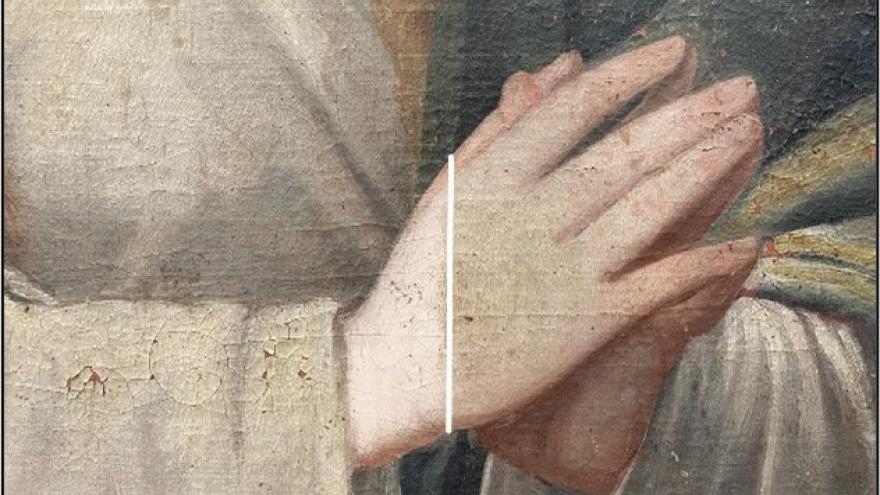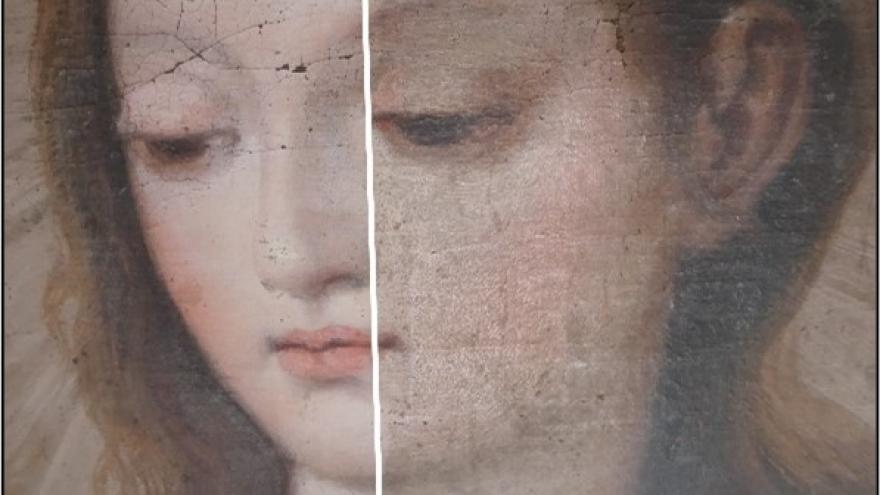

Restoration of the canvas The Immaculate Conception of the Charterhouse of Talamanca de Jarama
Located in the chapel of La Cartuja. Attributed to Pedro Atanasio Bocanegra
The work is located in the chapel of the Cartuja de Talamanca de Jarama, which depended on the Carthusian monastery of Santa María de El Paular, founded in Rascafría on the initiative of Juan I and Enrique II on August 29, 1390. Initially, in the place it now occupies the canvas of the Immaculate Conception, There was a work representing Saint Bruno, founder of the Carthusian Order, which could not be recovered due to its irreversible deterioration.
The Cartuja de Talamanca chapel has mural paintings on the ceiling and walls that represent, in addition to the Immaculate Conception, the Holy Trinity, Pentecost and the Mystical Lamb. On the sides there is a simulated marble plinth on which Saint Hugo, Saint Telmo and the Magdalene, the emblem of the House of Bourbon and the Carthusian shield are represented.
The Immaculate Conception of Mary canvas
The canvas is attributed to Pedro Atanasio Bocanegra, due to its compositional characteristics, although it lacks a signature, like other paintings made by the same author. The model of the composition is reminiscent of that of the Granada painter Alonso Cano, which hangs in the Oratory of the Sacristy of the Cathedral of Granada. The Immaculate Conception by Cano was made during the artist's prime, in the 60s of the XNUMXth century. The success of the composition was such that it became a model to follow in representations of the Virgin in the XNUMXth and early XNUMXth centuries.
The absence of documentary evidence does not allow us to know how the picture of Immaculate arrived at the Charterhouse of Talamanca, although the most plausible thing is that the Carthusians had requested an Immaculate Conception from their colleagues at the Granada Charterhouse and that they had commissioned the image from Pedro Atanasio Bocanegra, who had worked for the Charterhouse of Granada between 1670 and 1676.
Images of the canvas before and after its restoration:
Previous state of conservation
The canvas was in a delicate state of conservation, with the loss of polychrome, especially in the lower part of the canvas and the marked cracking, being the main problems affecting the work. The canvas was dismantled in the chapel, to be later transferred to the restoration workshop.
From a structural point of view, the surface of the canvas was stretched. At the time, one might think that the frame is the original since it is made of pine wood, assembled at the corners.
Once the canvas was removed from the frame, it was observed that it was cut into the frame, possibly to adapt to the frame, and was nailed to it around the entire perimeter on the front of the pictorial film. On the surface, the accumulation of dirt and the different layers of oxidized varnishes could be seen, which significantly affected the work, preventing optimal reading.
The iron nails holding the canvas together could also be seen on the front of the pictorial film. The entire work was dotted with stains, which suggests that it could have been near candles.
restoration project
The restoration conforms to the principles of reversibility in the treatments applied. Stable materials and products compatible with the work have been used without altering its physical and aesthetic characteristics to prevent and neutralize any degrading action.
Disassembly, protection and fixing of the polychrome
First, it was necessary to remove each of the iron nails that held the canvas to the stretcher on the front. After separating the canvas from the stretcher and placing it on a flat surface, it was wallpapered with organic glue and Japanese paper.
Once the canvas was wallpapered, using pressure and heat, it was ironed to ensure that the pictorial film settled again on the support and preparation.
Support treatment
The support was in perfect condition, not showing any type of break or tear. The painting is made up of two canvases joined by a seam vertically, its measurements being one meter on the left side and 0,40 cm. the right wing. Originally, the size of the painting was somewhat larger, since it is cut around its entire perimeter.
In order to reassemble the canvas, perimeter bands were added that allow it to be correctly braced and tensioned on the frame structure. The pine frame, formed by a single horizontal crossbar, has been preserved. At the ends of the crosshead it was reinforced with T-shaped plates.
Also carried out was manual cleaning of dirt remains on the edges of the canvas prior to placing perimeter bands.
Removing wallpaper and cleaning the pictorial film
After removing the Japanese paper, the cleaning process began, previously carrying out the pertinent analytical and solubility tests with the appropriate solvents.
First, the layer of dust and pollution was removed with an anionic soap diluted in water. Old and rusty varnishes were removed with a mixture of solvent and alcohol.
Coated
The leveling of unpreparedness was done in the same tone as the original.
Chromatic reintegration and final protection
Two coats of varnish were applied to protect the pictorial film. The reintegration was carried out with imitative and differentiable criteria in the small gaps and finally another protective layer of varnish was applied.
In the frame, the gold was first fixed to the wood and the decorative pieces were attached. Both the polychrome and the gilding were cleaned with a mixture of soap and alcohol and a layer of protection.
With these interventions the canvas The Immaculate Conception of Mary, of great pictorial quality, it has recovered its original attractiveness.















